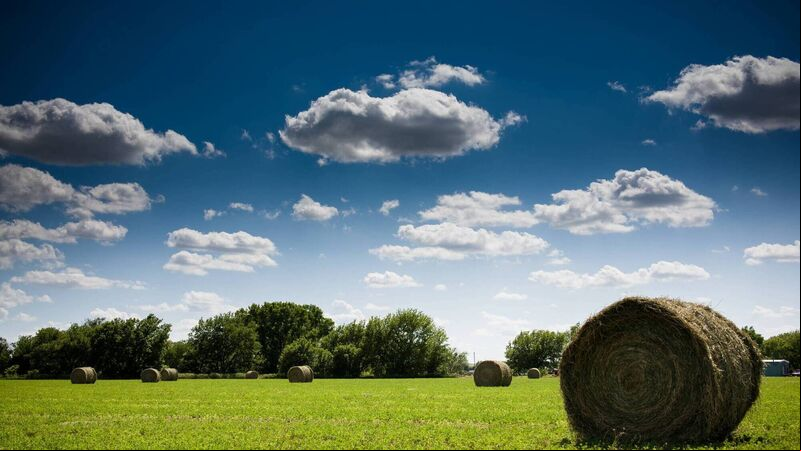Memories flood back of my 48 years farming as we save the hay

"People are under pressure and working long hours and fatigue comes in."
They say that all city and town dwellers in Ireland are really no more than three generations away from the countryside so even for urban folk saving the hay was part and parcel of their ancestral past.
We still had a working horse on the farm in the early 1960’s and I can just about jobs being done around the place with the horse and butt. We had a tractor also back then but the horse still did a few tasks like scuffling and opening drills for potatoes. Before my time the horse did all the hay work including turning the new mown grass with a rake called ‘the tumbling Paddy’ - I never saw it in action but the remains of it are above by the ditch in the Field Below the Chapel Field.
Horses go and tractors come, wynds and ‘cocks’ of hay are scarce now replaced by bales. For years we had small round and square bales but today it’s mainly ‘big’ bales. All these changes have happened in this last half century. The one thing that has remained constant in face of all these happenings is the smell of the hay crop. When grass is growing - whether for grazing by animals, for silage or for hay it’s got no particular aroma or smell. When it’s cut down and the sun and the wind get in on the action, all’s changed, utterly and beautifully changed.
As I pen these lines it’s a balmy July evening. The sun has just gone down but the back door and kitchen windows are open. The grass was cut on Sunday and turned for the first time on Tuesday and now that gorgeous smell comes wafting on the night breeze.
As I said we had wet days too, days when we were ready to ‘make up’ the small cocks of hay into wynds and down came the rain! Overall though I feel that when I was young we knew when Spring had arrived with the growth of grass, the lengthening days and April showers. Similarly when the Summer came we knew it -playing outside til nearly midnight, blue sky days and the stones on the ditches still warm late into the evening.
As a farm crop hay has lessened in importance. Once upon a time hay saved on each individual farm was the main food source for livestock during the winter. “Well saved hay was like having money in the Bank” was how I heard a neighbour describe to importance of the crop. Silage has come to take over this role for most farmers. Green grass is either put into a silage pit covered with sheets of plastic or made into bales in the field and wrapped in black plastic. The weather isn’t as vital for silage as from cutting to ‘preserving’ usually takes less than forty-eight hours. With hay from four or five days to a week is needed. The grass sward has to be cut, then turned several times in order to dry it out completely, then ‘raked in’ and finally baled. During all these operations that beautiful, evocative smell gets stronger and stronger.
Even driving along country roads at this time of year that smell ‘of days gone by’ is just so beautiful. Is there any other smell, anywhere in the word, that brings so many fantastic memories?
We have one field here, the Top Bog - I think it was last ploughed around 1967. Because of that the grasses, wild flowers and herbs growing there are truly of the old grassland meadow variety. We cut hay off it each year, sweet-smelling hay, you’d nearly ate it yourself! What makes hay so lovely and so palatable for cattle, cows, horse, calves and sheep is that variety of grass species, sure it’s like a mixed grill for livestock!
Make no mistake about it saving the hay was hard work especially if the sun was bating down. No one complained as that same sun was a vital ‘ingredient’ in ensuring fully dried grass turned into hay. But there was skill and judgement needed too by the farmer. Outside of the threat of rain one needed to know exactly when the hay was ‘ready’. A day extra in very hot conditions could see the crop drying out too much and ‘crisping up’ thus giving a very inferior feedstuff.
Hay making was hungry and thirsty work and ‘having the tay’ in the field was part of the annual ritual. We always got the shiny sweet gallons from Woods’s shop above in the village. The hot, sweet tea was served from the sweet gallon as the workers sat by a hay cock for a break. Sandwiches lathered in butter and scones seemed forever to come forth from a seemingly bottomless wicker basket.
The two prong pike was the favourite instrument for ‘making up’ the hay before mechanical turners became the norm. When we would have the dried hay made up into big cocks it was necessary to tie them securely for fear that a sidhe gaoithe would blown them down. Sometimes twine was crisscrossed over the cock and weighted down with stones but generally we used sugans. It took skilled hands to gently pull hay from the cock and twist it into a strong sugan or hay rope. The knack of doing it was to twist it tightly in such a manner that it didn’t unwind easily. Once the hay was made up in the large cocks and well secured there was no fear of it. Even if torrential rain came the conical shaped ensured the moisture just ran off and the hay would be perfect. We often left it in the field until well into August. Bringing the hay ‘home’ to the hay-shed in the haggard was another big adventure.
Maybe I’m old-fashioned or traditional but I do love the work this week as we convert green grass into beautiful hay. The hay comes from the same fields where my great grandfather would have cut it with a scythe in the 1870’s - somethings never change.
Of all the work done on our farm each year the haymaking is unique. It combines the soil, the grass and the different plants with nature -the sun, the wind and the age old greeting of ing neighbours as they survey the fields ’God bless the work’- the oldest yet newest thing. A man said to me Tuesday night ‘If only you could bottle and sell that smell- ‘twould be a great shower gel, after shave, air freshener and anti perspirant, all in one.
(From ‘Ante-Natal Dream’ by Patrick Kavanagh)







 App?
App?




